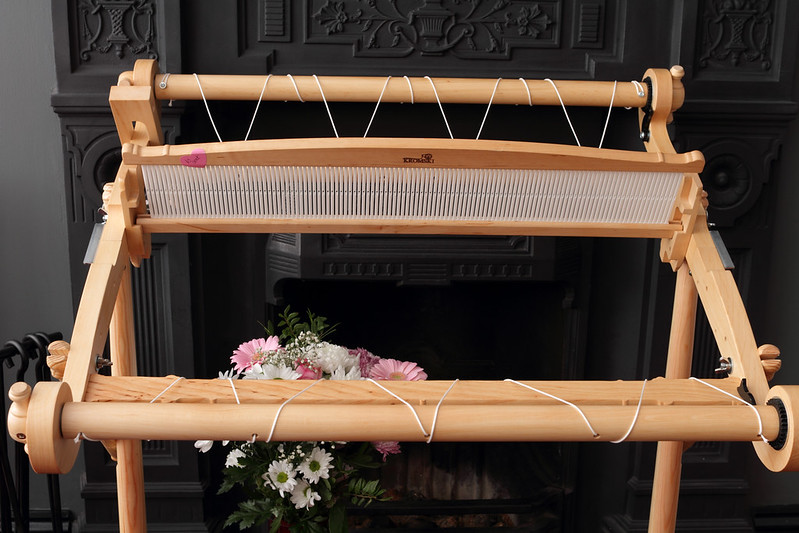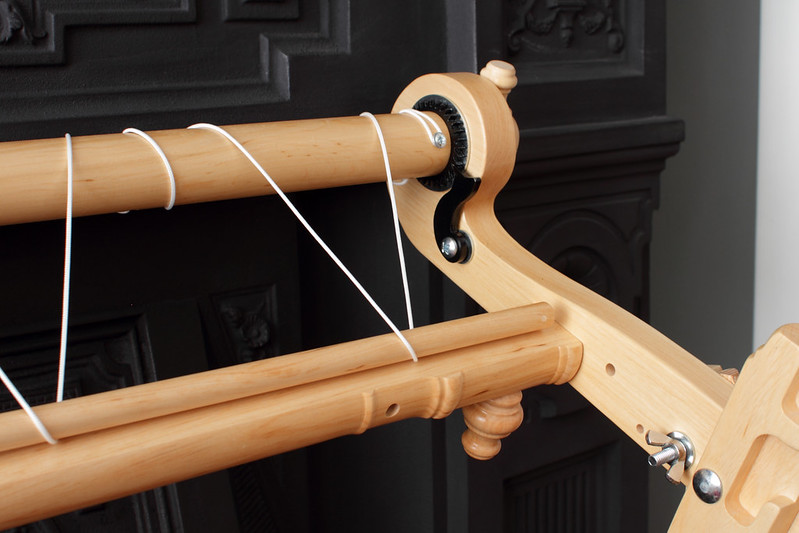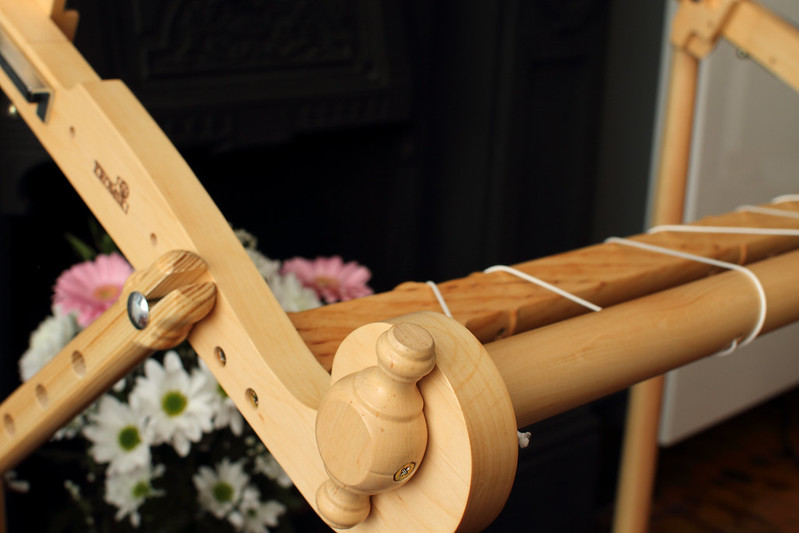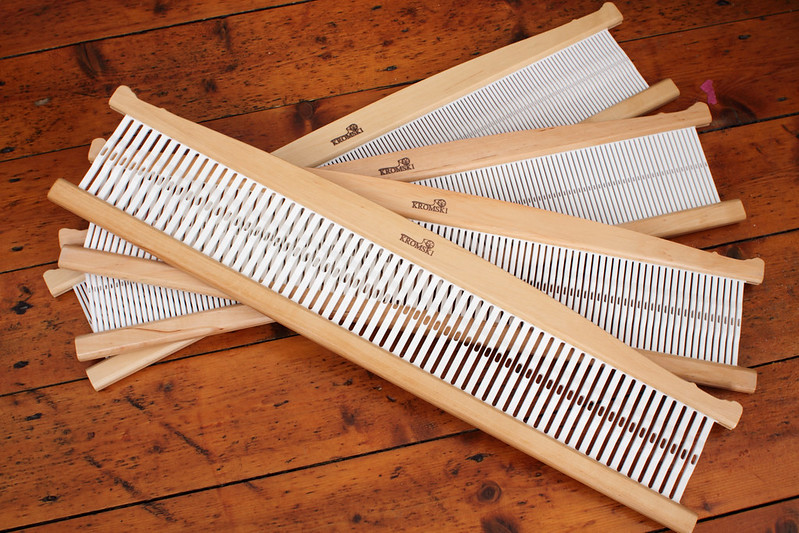A funny thing happened last year. On reading a couple of tongue-in-cheek comments about yarn-based hobbies getting out of control on The Twisted Yarn’s review of my Little Book of Yarn Dyeing, my partner turned to me and said “You know, maybe we have space for a loom”… all of a sudden there was a loom.
Of course, it didn’t happen just like that. Between the “well maybe I could get a loom” moment and clicking “add to basket”, I disappeared down a rabbit hole of several months answering the questions “what kind of loom?”, “which model?” and “what size?”. I won’t bore you with all of my loom research (I don’t think it would fit into a blog post, it could probably be the subject of a book), but my journey took me to eyeing up large floor looms before reigning myself back in, and settling on “Rigid heddle!” as the answer to the first question.
Rigid heddle looms are simple things; easy to set up and relatively cheap, and a sensible, low commitment option for someone like me who knows nothing about weaving. Their limitations are that they’re designed for plain weave only – though one can weave other patterns using one, but it is slow going. I really like twill patterns, so this was a big compromise for me. But realistically, I don’t know how to weave, so investing hundreds or even thousands of pounds on a multi-shaft loom would be a bit silly even if I could afford it.
Experienced weavers seem to like having a rigid heddle loom around for quick set up and portability, so if I ever decide to get a ‘proper’ loom down the line it’s still worth owning. A quick look on eBay suggests they hold their value well, so if weaving is not for me I should have no trouble finding it a new home.
See how easy it is to justify the purchase of a rigid heddle loom?
To answer the next question, “which model?”, this was easy, Kromski Harp. This was a quick decision because in the UK we don’t have that many options so it’s probably going to be the Harp or one of the Ashford models. The Harp has two advantages: 1) very strong metal ratchet and pawl system with clever magnetic thingy; and 2) flip it over and it’s got a built-in warp board, meaning one fewer accessory to buy. I think it might also have been cheaper than the equivalent Ashford too, but prices vary.
What size? There are a lot of options here and it came down to knowing that I wanted to make fabric to sew with (I see hand woven cushions and maybe even a coat in my future). I chose a 24″ because that’s enough for most pattern pieces while still fitting in the living room. Now that I have it, it was absolutely the right choice, any wider would feel unwieldy to use.
When considering what size of loom to get (you know, just in case you’re thinking about it), it’s worth knowing that you can make double-width fabrics on a rigid heddle loom if you get a second heddle, and panels can also be joined together to make blankets etc.
I ordered it, of course, from my favourite fibre store, Spin City, who now stock an impressive range of looms and weaving accessories.
There was one further question to answer before clicking “Confirm Order”: What accessories should I get? Short answer: all of them. I got a stand, and I can’t now imagine using it without the stand. It’s adjustable and at the lowest setting it’s perfect for weaving while watching TV on the sofa, the horizontal setting is ideal for warping and all the steps in between ensure it works for every kind of chair.
I also ordered a 12dpi heddle for fine yarn (it comes with an 8dpi for worsted-ish yarn). I quickly realised I wanted more heddles, so I added a 5dpi and a 10dpi to my Christmas list.
The loom appeared! Assembly was a little tricky, but was completed with only mild swearing. The manual could have been better on a few details, but Kromski have a YouTube channel with guides in English, which are very useful if you can endure the deadpan presenter.
I am very happy with my choice of loom. The build quality is excellent. I’m going to mention that my the front and rear beams were mislabelled in my kit just in case you happen to encounter the same problem, which led to the ratchet mechanism not engaging properly. This was fixed by simply swapping them over (but it would have been nice not to have had to rebuild it after the first project).
So, now just the simple business of learning to weave, which I’ll save for my next post. Hint: it was a steep learning curve!




A question if you will, milady… I want to get another reed/heddle thing for weaving 4-ply/fingering weight. I *think* this will be a 12… er… I want to say Dpi, but that’s fits perfectly inch… epi? Ends? Something per inch.
Anyway, I’m so glad I checked on my proper terminology before writing this post :D
Whole new world of jargon, isn’t it! Dpi = dents per inch, ie the number of holes in the heddle. Epi = ends per inch, or number of warp strands. They’re two ways of thinking about the exact same thing.
So what dpi for fingering? I have found wildly differing opinions on how to choose the right dpi for your yarn, but in my very limited experience a 10 or 12dpi. I used a 10dpi for my (thickish) sock yarn scarf, and it was a little weft dominant, I would definitely use a 12 for a fine 4 ply,but it depends on the effect you’re looking for. Do you want to see more warp? Then go finer, or more weft? Go coarser. My next post will share what I’ve learned so far.
Fits = dots. I give up.
To be fair to myself I’m xtrememy exhausted.
Ah – yes, weaving is big on the horizon for me but I only have a small house and it’s already housing two spinning wheels, 3 sewing machines and a huge stash of wool (from raw unwashed to finished skein awaiting a project). Also – I’m 60, have I enough time left to learn to weave?
OF COURSE you’ve got time! I was amazed how quick it is to get going and make something of a good standard. It sounds like you need a use for all that lovely wool, and weaving is certainly a way to use a lot of wool!
Thank you for this post – I have been contemplating buying a loom for the past year and spent Saturday looking at another shop which carries the Ashford loom. I was leaning towards the Kromski and after reading your post have made my decision! And thank you for the advice on the various sizes of heddles. I had not thought about getting more sizes but will order them with my loom and stand as well.
It’s 2 years after your original post, are you still weaving?
Fantastic! I am sure you will enjoy your new loom. There is so much you can do with a rigid heddle. I am still very happy with the Kromski and still weaving. I have a few larger projects planned with handspun, and it’s taking me a while to get the yarn spun!
Thank you for this and your subsequent posts. I have a Brinkley loom which I love, though I have not made loads on it yet. I’m eyeing up a rigid heddle. Are there significant advantages of a rigid heddle if a person already has a Brinkley?
I love your honesty and practical advice thank you.
Bec
I love my Kromski 24″ loom. I loved it before I bought the stand and I love more now that I have the stand. Although I found working from a table with the loom in my lap or on the table to be comfortable I am a pack animal and want to be around my family in the evening and the stand allows me to adjust the height and distance for just such occasions. I have just purchased the double heddle holder and a 12 dent heddle and can’t wait to try them out. I forgot to order the second 8 dent heddle so I can’t double up quite yet but I have been watching the Kelly Cassanova videos and others on the technique for double heddle weaving. Not as difficult as I thought it might be.
Lucky you! I haven’t got the double heddle kit yet, I am itching to get one!
I wonder if anyone out there is able to help?
I’m very new to weaving and bought a Harp 16 for the fact that it folds and I can take it in the motorhome with me.
My problem is that my downshed is so tight while my upshed seems too loose. I’m sure I’ve got the heddle block in the right place so does anyone know if I could raise the block a little so that tensions of the upshed and downshed are more equal?
Thanks in advance.
Doh! Please ignore query. I showed the problem to my husband and straight away he said “ You’re forcing the reed down to an even lower position on the heddle block than it’s supposed to go!” Problem solved and it’s made such a difference to everything! Except that now I feel like an idiot!
Thanks for helping in my decision process. I’m in Nebraska and knitting and spinning support is good but not many weaver’s.. let alone looms to try. So going for this sight unseen.